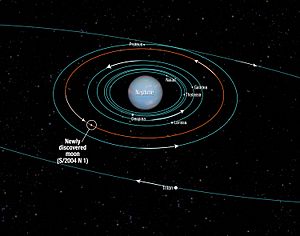List of Neptune's moons facts for kids
The Neptunian moons are listed here by orbital period, from shortest to longest. Irregular (captured) moons are marked by color. The orbits and mean distances of the irregular moons are variable over short timescales due to frequent planetary and solar perturbations, therefore the listed orbital elements of all irregular moons are averaged over a 30,000-year period: these may differ from osculating orbital elements provided by other sources. Otherwise, recently-discovered irregular moons without published proper elements are temporarily listed here with inaccurate osculating orbital elements that are italicized to distinguish them from other irregular moons with proper orbital elements. Their orbital elements are all based on the epoch of 1 January 2020. Triton, the only Neptunian moon massive enough for its surface to have collapsed into a spheroid, is emboldened.
| Key | |||||
|---|---|---|---|---|---|
| Inner moons |
♠ Major moons |
† Nereid (ungrouped) |
‡ Halimede (ungrouped) |
♦ Sao group |
♥ Neso group |
| Label |
Name | Pronunciation (key) |
Image | Abs. magn. |
Diameter (km) |
Mass (×1016 kg) |
Semi-major axis (km) |
Orbital period (d) |
Orbital inclination (°) |
Eccentricity |
Discovery year |
Year announced | Discoverer |
Group |
|---|---|---|---|---|---|---|---|---|---|---|---|---|---|---|
| III | Naiad | 9.6 | 60.4 (96 × 60 × 52) |
≈ 13 | 48224 | +0.2944 | 4.691 | 0.0047 | 1989 | 1989 | Voyager Science Team | inner | ||
| IV | Thalassa | 8.7 | 81.4 (108 × 100 × 52) |
≈ 35 | 50074 | +0.3115 | 0.135 | 0.0018 | 1989 | 1989 | Voyager Science Team | inner | ||
| V | Despina | 7.3 | 156 (180 × 148 × 128) |
≈ 170 | 52526 | +0.3346 | 0.068 | 0.0004 | 1989 | 1989 | Voyager Science Team | inner | ||
| VI | Galatea | 7.2 | 174.8 (204 × 184 × 144) |
≈ 280 | 61953 | +0.4287 | 0.034 | 0.0001 | 1989 | 1989 | Voyager Science Team | inner | ||
| VII | Larissa | 6.8 | 194 (216 × 204 × 168) |
≈ 380 | 73548 | +0.5555 | 0.205 | 0.0012 | 1981 | 1981 | Reitsema et al. | inner | ||
| XIV | Hippocamp | 10.5 | 34.8±4.0 | ≈ 2.2 | 105283 | +0.9500 | 0.064 | 0.0005 | 2013 | 2013 | Showalter et al. | inner | ||
| VIII | Proteus | 5.0 | 420 (436 × 416 × 402) |
≈ 3900 | 117646 | +1.1223 | 0.075 | 0.0005 | 1989 | 1989 | Voyager Science Team | inner | ||
| I | Triton♠ | –1.2 | 2705.2±4.8 (2709 × 2706 × 2705) |
2139000 | 354759 | −5.8769 | 156.865 | 0.0000 | 1846 | 1846 | Lassell | |||
| II | Nereid† | 4.4 | 357 ± 13 | ≈ 2400 | 5504000 | +360.14 | 5.8 | 0.749 | 1949 | 1949 | Kuiper | |||
| IX | Halimede‡ | 10.0 | ≈ 62 | ≈ 12 | 16590100 | −1879.30 | 113.1 | 0.286 | 2002 | 2003 | Holman et al. | |||
| XI | Sao♦ | 11.1 | ≈ 44 | ≈ 3.4 | 22239300 | +2918.70 | 53.3 | 0.148 | 2002 | 2003 | Holman et al. | Sao | ||
| S/2002 N 5♦ | 11.2 | ≈ 38 | ≈ 3 | 23365200 | +3141.26 | 42.1 | 0.548 | 2002 | 2024 | Holman et al. | Sao | |||
| XII | Laomedeia♦ | 10.8 | ≈ 42 | ≈ 3.4 | 23502300 | +3175.65 | 37.7 | 0.409 | 2002 | 2003 | Holman et al. | Sao | ||
| X | Psamathe♥ | 11.0 | ≈ 40 | ≈ 2.9 | 47611900 | −9149.87 | 126.6 | 0.417 | 2003 | 2003 | Sheppard et al. | Neso | ||
| XIII | Neso♥ | 10.7 | ≈ 60 | ≈ 11 | 49871600 | −9796.67 | 126.9 | 0.400 | 2002 | 2003 | Holman et al. | Neso | ||
| S/2021 N 1♥ | 12.1 | ≈ 25 | ≈ 0.8 | 50623600 | −10017.93 | 134.5 | 0.441 | 2021 | 2024 | Sheppard et al. | Neso |
See also






